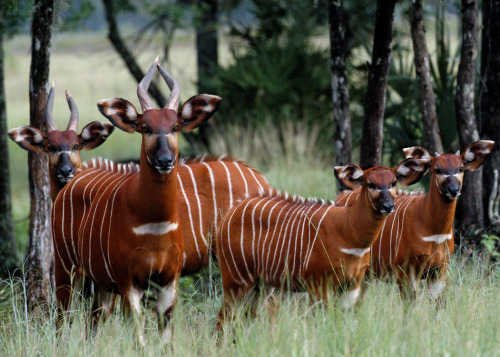

In a significant move to protect one of Africa's rarest antelopes, Kenya has welcomed an additional 17 Mountain Bongos from Florida, USA.
The plane carrying the animals touched down at the Jomo Kenyatta International Airport (JKIA) on February 23, 2025, before they were transported to Meru where they will be integrated into breeding and protection programmes.
Early last year, the country repatriated another 10 animals from the US boosting their population at the Mawingu Bongo Sanctuary to 24.
It follows the arrival of a similar number from various zoos in North America in 2014, with the birth of four calves since then.
Kenya’s ambitious plan is to establish a national population of 750 Mountain Bongos within the next 50 years as part of the ongoing conservation efforts aimed at saving the species.
The historic repatriation is the result of a collaborative effort between the Kenya Wildlife Service (KWS), DHL, Kenya Veterinary Services, the Meru County Government, the Meru Bongo and Rhino Conservation Trust (MBRCT), Lewa Wildlife Conservancy, and the Rare Species Conservatory Foundation (RSCF).
The 17 bongos (12 females and 5 males) will form a founder population at the Marania and Mucheene sanctuary in Meru County.
The sanctuary, established through a partnership between KWS, MBRCT, and local communities, will serve as a breeding and rewilding centre, with the ultimate goal of reintroducing the bongos into their natural habitats.
Upon arrival, the bongos were transported to the Marania and Mucheene sanctuary, where they will be placed in an isolation facility for at least three months.
What to know about Mountain Bongos
Mountain Bongos (Tragelaphus eurycerus isaaci) are a subspecies of the Bongo, a type of forest antelope found primarily in the mountainous forests of central Kenya.
They are a critically endangered antelope whose population has drastically declined from approximately 500 individuals in the 1970s to fewer than 100 in the wild today in Kenya.
This decline is primarily due to habitat loss, poaching, illegal activities, disease, and small fragmented populations, threatening the survival of this rare species.
Recognisable for their striking orange coat with white vertical stripes, these antelopes are known for their elusive nature and are adapted to living in dense, mountainous forest areas.
They are endemic to the Aberdare, Mount Kenya, Cheranganis Hills and the Mau Forests Complex, with only a few individuals left in the Eburu, Maasai Mau and South Western Mau.
Why are they unique?
Mountain Bongos are unique not only for their distinct physical features but also for their ecological importance.
As forest-dwelling herbivores, they play a crucial role in maintaining the balance of their habitat by grazing on vegetation that helps prevent overgrowth.
They are also an important part of the region’s biodiversity, contributing to the complexity and richness of the ecosystem.
Their rarity, combined with their striking appearance, has also made them a focal point of wildlife conservation efforts.

The threats they face
The destruction of forests due to logging, agriculture, and human settlements has led to their numbers drastically reducing over the years.
Without sufficient cover, the species is left vulnerable to predators and harsh environmental conditions.
Like many endangered species, Mountain Bongos also face the constant threat of poaching as they are targeted for their meat and hides, which are highly valued in the illegal wildlife trade.
Diseases, often transmitted by domestic livestock, have further strained the already fragile population.
Speaking during the reception at JKIA, Tourism and Wildlife Cabinet Secretary Rebecca Miano, emphasised the importance of the initiative.
“The return of these mountain bongos is not just a conservation success; it is a symbol of hope and renewal for Kenya’s biodiversity. This initiative demonstrates what we can achieve when we work together—across borders, disciplines, and communities,” she said.
Kenya Wildlife Service Director General Erustus Kanga highlighted the alignment of the project with the KWS corporate Strategic Plan 2024-2028.









